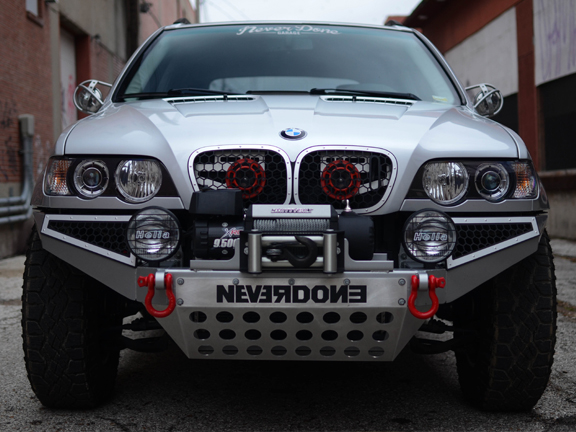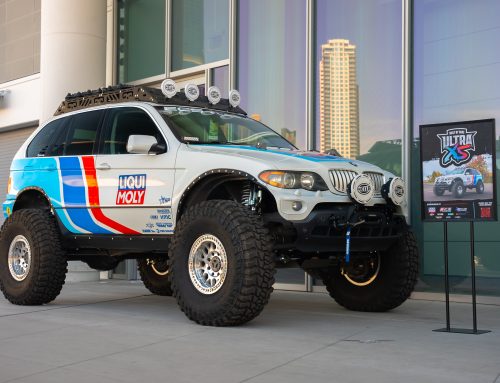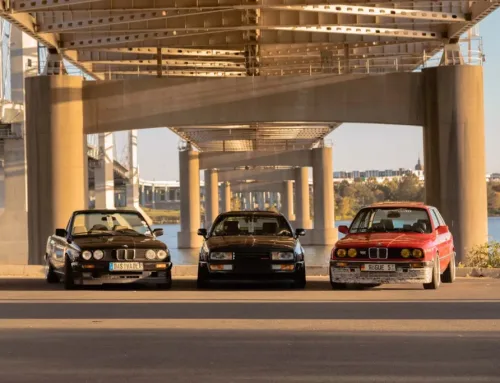We all love the underdog story. The plot is one we can trace back to the Epic of Gilgamesh and the Bible, the David and Goliath story. Perhaps more relatable to us car folk would be the story of Takumi Fujiwara in Initial D, where an unknown kid from a mountain town in Japan bested some of the country’s top touge drivers and their superior cars with the humble ‘Fujiwara Tofu Shop’ AE86. More recently, reality has provided yet another clash between a titan and a mortal here in the BMW community. Tyler Coey, the brains behind Never Done, loaded up his sling with a few stones to defend himself, his creative rights, and the liberties of which we enthusiasts are so frequently stripped at the hands of companies like his adversary, the unfathomably large ExxonMobil corporation.

Our protagonist found himself confused, frustrated, and slightly tickled when he received a letter from the legal team at ExxonMobil two weeks ago. In the parking lot of UPS, he tore open the envelope to read its contents. To his surprise, It contained a stern cease-and-desist order. As a toy designer who moonlights creating one-off fabrications for the M Coupe and E46 M3 models, he did not expect to receive something from a relatively unrelated company in reference to what they claim is an intellectual property violation on Tyler’s part.


Their claim was related to Never Done’s lovable, if not a little off-putting, “Pegasloth,” the cynical mascot of Tyler’s passion project. As a character, the Pegasloth represents the attitude of Never Done. The goofy chimera is something out of place, slightly humorous, and almost oxymoronic when associated with a race car, which was exactly Tyler’s intention when he sketched and designed his catchy identifier. Never Done is, according to its owner, a creative outlet for the fun and goofy to meet the solemn and serious BMW motorsports world. What better way to pay tribute to those characteristics than an homage to the winged beast found on James Dean’s Porsche 356 Speedster?
“I just drew him (Pegasloth). I did it because I wanted to, which is kind of how everything (with ND) starts. It was an obscure, funny thing, to me and the first people that knew about it.”
Never Done is a collection of ‘what ifs.’ Tyler, who designs toys for certain chain restaurants’ kid’s meals by day, began his small company by creating parts he wanted for his own cars. When other owners saw his work, he began to receive requests for those parts he made for himself. As a staunch defender of the BMW community and an amenable fellow, he naturally agreed to begin producing batches of what were once one-off pieces. As the company grew, it became more than just a pet project. Now, Tyler works with a large vendor to help distribute his products to a wider audience of enthusiasts, while he maintains his position as an artist who creates for himself. This growth, it seems, was enough to catch the attention of yet another company looking to roll over what it assumed would be a lay-down. So, the ExxonMobil legal department contacted Tyler in hopes of preserving their alleged dignity, if a big oil company can have such a thing.

That supposed threat to their image is none other than the Pegasloth, for reasons Tyler still fails to understand, despite lengthy correspondence with Exxon’s legal representation. Somehow, the company asserts that Never Done’s furry, three-toed, crest is:
“..confusingly similar to the Pegasus Device, the ‘Pegasloth’, in connection with certain vinyl stickers intended for affixation to vehicles promoted by your business and at never-done.squarespace.com/garage/pegasloth” (Exxon legal)
Tyler, being an artist and a creator, felt the letter was unwarranted and, in his opinion, little more than corporate bullying. With the resources of the twelfth-largest company in the world up against him, there was certainly an initial shock and fright with that first letter. Monopolizing petroleum and, by proxy, a large part of the transportation industry, seems to be just the beginning for Exxon. Now, having a definitively authoritarian control over the largest market in the world, they must have little else to do but target caricatures bearing one or two passing similarities to one of their own.
Actually, to insert a bias, ‘one or two’ similarities is a stretch. The Pegasloth in question shares no similarities, other than a pair of wings, with the Exxon Pegasus. Additionally, it seems even more of a far cry for a company to claim intellectual property rights to a mythical creature. Would this mean Exxon owes years of back royalties to Ancient Greece? What about Disney? My Little Pony? How do they define this creature as intellectual property in the first place?
According to Exxon in their first letter, their major concern was:
“While we admire the creativity of your artistic endeavor, ExxonMobil is concerned that ongoing use of the ‘Pegasloth’ Device in this manner will confuse consumers into incorrectly assuming that your product or business has some affiliation or connection with ExxonMobil or that it is licensed by ExxonMobil, and could dilute the distinctive famous Pegasus Device or tarnish the reputation thereof, contrary to federal law.”
To translate from legalese to English, Exxon’s primary worry is that BMW enthusiasts will somehow affiliate Never Done with ExxonMobil based on both companies using a winged creature ‘Device’ or that it is somehow a direct affront to their oh-so-original ‘Pegasus Device.’ I’d like to ask Hesiod, the Greek poet, what he thinks of ExxonMobil’s claim to ownership over the mythical pterippus. Upon further refreshing on Greek mythology, it is also clear that ‘Pegasus’ is the proper noun, or name, of the most famous pterippus, who was a child of Poseidon and foaled by the Gorgon Medusa. So unless ExxonMobil wrote the ancient mythology of the Greeks, it is fairly definitive to say they own no such rights to Pegasus, and have a general misunderstanding of his established identity.
Tyler was naturally defensive but otherwise collected after reading their letter. Instead of defiantly ignoring their missive, or parrying with aggressive retaliation, he responded tactfully. His return letter outlined his artwork, the ethos of Never Done, and provided examples of his inspiration. With pictures of James Dean’s Porsche alongside the Pegasloth affixed in a similar fashion to a silver E36, the only striking resemblance between characters seen so far was presented.


“The Pegasloth character was inspired by the genre of vintage racing, specifically, James Dean’s Porsche 356 (pictured) featuring pegasus graphics on the fenders. Pardon my explaining the joke, but it’s the juxtaposition of a sloth in a situation classically associated with speed. In your letter, you specifically cited my photograph featuring the fender mounted Pegasloth decals – that intended location further nods to, and validates, the reference. Pegasloth’s appeal is the unexpected context of a sloth, not a brand, and people instantly recognize the parody of source material without any confusion.”
Tyler continues his letter with a polite dispute to the claim that any risk at all exists for consumer confusion. What he did not say, that almost goes without saying, is the absurdity that a consumer would associate Pegasus with ExxonMobil at all. Further investigation of the logo in question reveals a number of interesting facts about the history of ExxonMobil and their ‘iconic’ Pegasus. According to their own History page, “The flying red horse (not a pegasus) was first used by Vacuum Oil (not ExxonMobil) in South Africa (not America) in 1911. In 1931, when Vacuum merged with Socony (still not ExxonMobil), the red Pegasus – a symbol of speed and power – was adopted as its U.S. trademark. In 1968, Mobil adopted new-look Pegasus service stations.”

Naturally, ExxonMobil was adamant in their claim of ownership to this particular winged horse. Their reply to Tyler’s explanation came quickly and doubled-down on their assertions. A day after his response, Tyler’s phone displayed the ExxonMobil legal team’s number. His phone conversation yielded repetitive topics that seemed to indicate confusion on the part of their attorneys as to what the real issue actually was. According to Tyler, their focus shifted from consumer confusion to trying to disqualify the Pegasloth as a parody. By attacking the parody claim, this inherently validated that the claimed protection under parody usage was valid and recognized, so she had to dismantle that claim.

“I still can’t believe a sloth in the context of racing needs explanation, but I unnecessarily explained the joke anyway. Then she charged Pegasloth as defaming because he suggests that ExxonMobil makes your car perform poorly. I told her I wasn’t trying to be combative, but that she did say it wasn’t a parody because it didn’t have commentary or criticism. That statement gave him some.
According to Tyler, the ExxonMobil lawyer realized she had qualified Pegasloth as a parody by her own definition and quickly dismissed the point to continue talking in circles.
At the end of his call, Tyler still felt confused enough as to where both parties stood that he had to ask for clarification:
“So, where do we stand with this? Are we good here?” He asked.
His question was met with a pause and eventual response from the legal team that they would extend the cease and desist from fourteen days to thirty days for the Pegasloth to be removed from his site. This adds more confusion, since, if there is such a risk of Never Done being confused with the largest oil company in the world, wouldn’t more time potentially cause more confusion? If it is so pressing, what is the purpose in allowing an additional two weeks of printing that would naturally put more Pegasloths into existence, forever confusing the masses as to Tyler’s affiliation with ExxonMobil?
The call was followed with another message from their legal team, which continued their dispute to Tyler’s creative rights claim:
“ExxonMobil further disagrees that the ‘Pegasloth’ constitutes parody under currently applicable standards, and specifically, the commercial marketing of the sale of the ‘Pegasloth’ stickers indicates an intent beyond artistic parody; there is no criticism, commentary, or transformation to establish any other reason for the creation and use of the ‘Pegasloth’.”
This is puzzling indeed, as their description here indicates a vastly different concern than they initially expressed. Their first message seemed focused on the Pegasloth’s potential message and that he stood for something. Their letter that followed the call, however, stated that it is not a criticism, commentary, or transformation, thus implying it stands for nothing other than a direct affront to their logo. As was proven by Tyler, the Pegasloth is indeed a parody, but not of ExxonMobil’s character, and is certainly definable as such. It is definitely not a direct attack on ExxonMobil, it is not a parody of their character, nor could it ever be both.
Fortunately, this backtracking in the ExxonMobil logic was exactly the mental breakthrough Tyler needed. Before the letter, Tyler felt cornered. In his mind, there were two options: either lay down and give up or defiantly persist and face inevitable legal battles for years to come. The name of his company is Never Done, so laying down and giving up isn’t in Tyler’s bag of tricks. Sadly, matching the legal budget of a massive company wasn’t either. The letter, though, provided Tyler with just the inspiration he needed to attack the problem with artistic integrity and humor, effectively creating a third option. He chose not to play their game with their rules and demonstrated his abilities as an artist, a creative, and an enthusiast.
His final letter introduced ExxonMobil, and the world, to Pegasloth v2. With sincerity and the sarcasm of a man determined to defend his creation, Tyler drafted the final letter and hit ‘send’.
“Dear (redacted),
I do not concede and maintain my stance with absolute confidence. According to Stanford University, under fair-use law (quote) — a fairly extensive use of the original work is permitted in a parody in order to conjure up the original.— Pegasloth is a textbook parody, but I digress; a long path proving the plainly obvious does not appeal to me. Instead, I have decided to solve this as an artist, not a lawyer.”


As you can see, Pegasloth now sits in a ‘signature chill pose,’ uses distinctly different colors from the ExxonMobil Pegasus Device, has a belly full of commentary and criticism, and, perhaps most importantly, is still not a horse.
This interaction is one that proves two important truths in the world. First, if there is an opportunity, however small, for an infinitely wealthy organization to either profit from or prevent the profits of another company, they will pursue action relentlessly. Second, as long as there are creative artists with a sense of humor and conviction, the world will forever be safe from the former. While it may not be the perfect ‘poetic justice’ some might hope for, in that the Pegasloth did change, it is an effective victory for the underdog.
How you might ask, is this a victory and not concession? The answer lies in the context of this entire dispute, which is, that somehow consumers could be driven away from ExxonMobil or make a purchase choice at a boutique BMW motorsport store thinking they were buying oil, gas, or some other ExxonMobil product. They were so afraid of a humble enthusiast company with no relation to their industry inciting mass confusion that they themselves created a much more visible Pegasloth. There is your poetic justice. Were they to leave well enough alone, the Pegasloth would continue to exist under the radar, standing for nothing, providing a simple chuckle for those with a quirky sense of humor. However, thanks to their legal action, the Pegasloth now exists as a symbol of defiance, artistic rights, and the victorious fight against corporate fascism.
The Pegasloth story is one that should resonate with consumers everywhere. In this modern age where companies have a more direct line to consumers than ever before, we consistently forget that their friendly-seeming social presences exist solely to lull us into believing they are trendy, approachable, trustworthy, and, above all, the preferred source of whatever product or service they provide. Then, there are those like Tyler, who create and distribute from a true sense of passion. His artistic talent and enthusiasm for BMW motorsport have brought the community an incredible company that, by some odd turn of events, has also given us a wonderful story reminiscent of the oldest underdog victory. To conclude, somewhat appropriately, Emperor Palpatine, in his conversation with Anakin at that weird opera thing, made the most intelligent statement in the entire prequels: “All those who gain power are afraid to lose it.” With ExxonMobil’s nearly unlimited power, in their quest to prove how absolute it is, ultimately failed so tremendously that their failure incited the very reality they were so afraid to see happen. Thankfully, Tyler persisted, and we have a Pegasloth for the people.

ExxonMobil was contacted for statements but did not return any messages, this article will be updated if and when their legal team responds with information. All images, messages, and mentioned products are owned by their respective companies. All images, messages, and products were included by Never Done and Tyler Coey.







pegasloth.. what a story. I would have never heard of this if it wasn’t for Exxon’s dumbass legal team. I didn’t fuel up there before but I’ll be damn sure not to now!
i’m so glad you enjoyed the read. Tyler is such an awesome guy and it absolutely tickles us to think this would never have been connected to them in any way had they not made the assertion that it somehow violates their intellectual property.